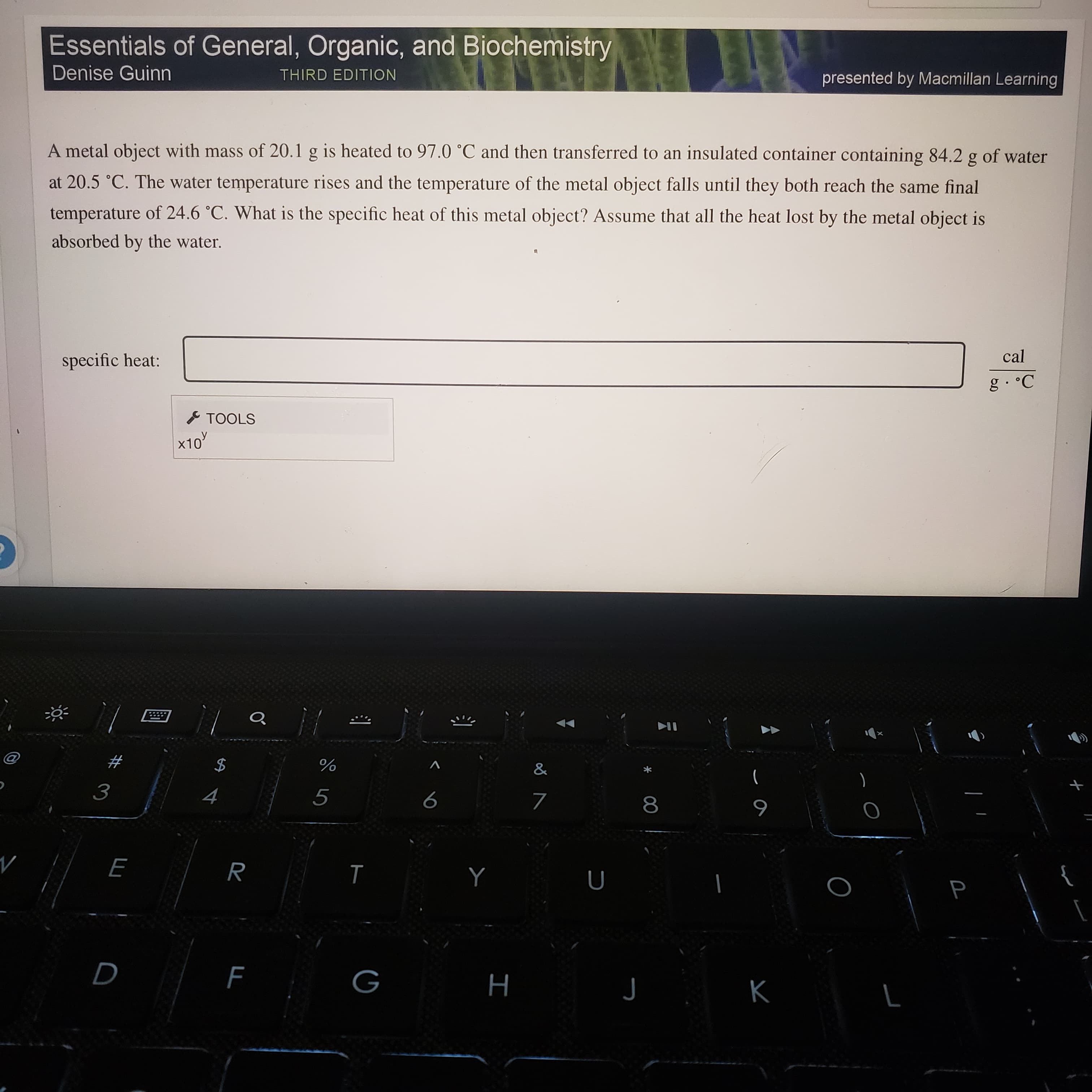Denise Guinn THIRD EDITION presented by Macmillan Learning A metal object with mass of 20.1 g is heated to 97.0 °C and then transferred to an insulated container containing 84.2 g of water at 20.5 °C. The water temperature rises and the temperature of the metal object falls until they both reach the same final temperature of 24.6 °C. What is the specific heat of this metal object? Assume that all the heat lost by the metal object is absorbed by the water. specific heat: cal g. °C I TOOLS x10
Denise Guinn THIRD EDITION presented by Macmillan Learning A metal object with mass of 20.1 g is heated to 97.0 °C and then transferred to an insulated container containing 84.2 g of water at 20.5 °C. The water temperature rises and the temperature of the metal object falls until they both reach the same final temperature of 24.6 °C. What is the specific heat of this metal object? Assume that all the heat lost by the metal object is absorbed by the water. specific heat: cal g. °C I TOOLS x10
Principles of Modern Chemistry
8th Edition
ISBN:9781305079113
Author:David W. Oxtoby, H. Pat Gillis, Laurie J. Butler
Publisher:David W. Oxtoby, H. Pat Gillis, Laurie J. Butler
Chapter12: Thermodynamic Processes And Thermochemistry
Section: Chapter Questions
Problem 14P
Related questions
Question

Transcribed Image Text:Essentials of General, Organic, and Biochemistry
Denise Guinn
THIRD EDITION
presented by Macmillan Learning
A metal object with mass of 20.1 g is heated to 97.0 °C and then transferred to an insulated container containing 84.2 g of water
at 20.5 °C. The water temperature rises and the temperature of the metal object falls until they both reach the same final
temperature of 24.6 °C. What is the specific heat of this metal object? Assume that all the heat lost by the metal object is
absorbed by the water.
specific heat:
cal
I TOOLS
x10'
#
)
8.
6
H
Expert Solution
This question has been solved!
Explore an expertly crafted, step-by-step solution for a thorough understanding of key concepts.
This is a popular solution!
Trending now
This is a popular solution!
Step by step
Solved in 2 steps with 2 images

Knowledge Booster
Learn more about
Need a deep-dive on the concept behind this application? Look no further. Learn more about this topic, chemistry and related others by exploring similar questions and additional content below.Recommended textbooks for you

Principles of Modern Chemistry
Chemistry
ISBN:
9781305079113
Author:
David W. Oxtoby, H. Pat Gillis, Laurie J. Butler
Publisher:
Cengage Learning

Chemistry
Chemistry
ISBN:
9781305957404
Author:
Steven S. Zumdahl, Susan A. Zumdahl, Donald J. DeCoste
Publisher:
Cengage Learning


Principles of Modern Chemistry
Chemistry
ISBN:
9781305079113
Author:
David W. Oxtoby, H. Pat Gillis, Laurie J. Butler
Publisher:
Cengage Learning

Chemistry
Chemistry
ISBN:
9781305957404
Author:
Steven S. Zumdahl, Susan A. Zumdahl, Donald J. DeCoste
Publisher:
Cengage Learning


Chemistry: An Atoms First Approach
Chemistry
ISBN:
9781305079243
Author:
Steven S. Zumdahl, Susan A. Zumdahl
Publisher:
Cengage Learning

Chemistry: Principles and Reactions
Chemistry
ISBN:
9781305079373
Author:
William L. Masterton, Cecile N. Hurley
Publisher:
Cengage Learning

Chemistry for Engineering Students
Chemistry
ISBN:
9781337398909
Author:
Lawrence S. Brown, Tom Holme
Publisher:
Cengage Learning